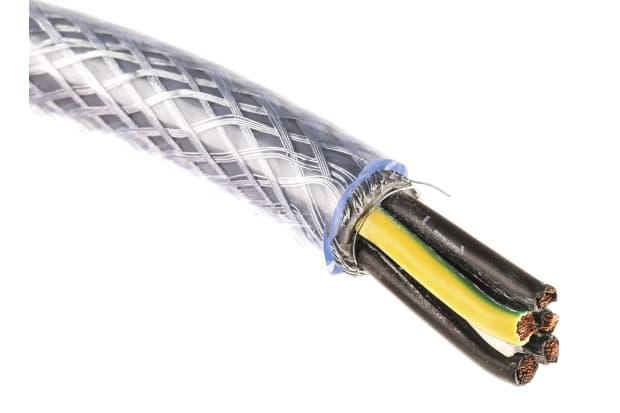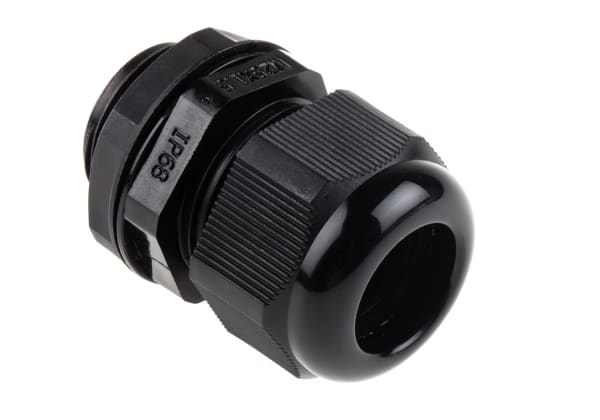- Published 30 Jan 2023
- Last Modified 29 Aug 2023
- 8 min
A Complete Guide to SY Cable
Our SY cable guide explains what it is used for, SY cable specification, sizes, current capacity, and more.

What is SY Cable?
SY cable is an industrial, reinforced cable designed to provide control functions in demanding environments where resistance to high levels of stress without a loss of flexibility is required. It features galvanised steel wire braid (GSWB) beneath a transparent PVC sheath. The transparency ensures that any corrosion or damage within the cable is immediately visible. The GSWB should have at least 55% coverage of the inner cable; anything less is unlikely to be sufficiently robust or reliable.
SY cables are multicore. This means that they contain a varying number of copper conductors protected by PVC insulation.
This product has several alternative names including flex cable, multiflex cable, steel wire braid cable, SY control cable, instrumentation cable, braided control cable, and control flex.
What is SY Cable Used for?
SY cable is used to control and regulate conveyors, instrumentation, assembly lines, production lines, and similar process automation equipment. It can also regulate air conditioning systems.
Process automation is the automatic control of a stage in an industrial process, such as the manufacture of a product. Process automation equipment typically features a combination of sensors, controllers and actuators (to switch devices on or off).
SY cable has a variety of uses in construction, transportation, manufacturing, power generation and other industries.
SY Cable Specifications

SY cable specifications mean it is primarily designed for use with fixed equipment but it can also connect fixed and mobile installations. Most varieties are compatible with medium to high voltages and can withstand movement and damp or wet environments - including oil and water. SY cable is not suitable for use outdoors or in fixed wiring applications that require compliance with British Standard 7671. This is because the braid may melt if exposed to heat generated by a short circuit.
SY cable derives its name from codes used by CENELEC, the Comité Européen de Normalisation Électrotechnique (the European Committee for Electrotechnical Standardisation). S refers to steel wire braid and Y denotes the widely used polymer PVC (polyvinyl chloride).
SY Cable Rating
Like other electrical wiring, SY cables have different Voltage ratings. Voltage is the difference in electrical charge between two points and this affects the pressure or strength of a charge as it passes through a conductor. By far the most common Voltage rating for SY cables is 300/500 Volts - i.e. they are compatible with both 300 and 500-Volt charges. However, you will also find cables specifically rated for either 300 or 500 Volts, as well as:
Diameters and Cores Explained
SY cables contain a varying number of cores or internal electrical conductors. A higher number of cores allows a greater level of flexibility and higher current capacity ratings. However, since cores can vary in size, there is no direct correlation between the number of cores and the outside diameter of the SY cable.
For example, while 10mm cables typically have four cores, some 16mm cables have three and others five cables. Six-core SY cables can have an outer diameter of 12.3mm or 13.35mm. Meanwhile, some 25-core SY cables have an outer diameter of 16.3mm while others are 19.7mm.
SY Cable Current Carrying Capacity
The SY cable current-carrying capacity is the amount of electrical current with which a cable is compatible. The term current refers to the speed at which an electrical charge passes through a circuit. Current is measured in amperes, more commonly known simply as amps.
Here are some of the most common current ratings:
SY Cable Glands

SY cable glands are fittings used to attach these products to devices or equipment. They provide an electrical connection for the inner connectors as well as the steel braid. Cable glands provide strain relief, helping the cable to stay in place if tugged, and they can also seal cables that pass through bulkheads or plating. They are sometimes described as mechanical cable entry devices.
Cable glands can be made from a variety of plastics, but when intended for use in demanding industrial settings, they are typically constructed from steel, aluminium or brass. Some SY cable glands feature natural or artificial rubber seals for moisture or gas resistance.
SY Cable Gland Sizes
To choose the right size gland for an SY cable, you will need to know the number of cores (inner conductors) as well as its outer diameter. The inner diameter of the cable gland must exceed the outer diameter of the cable or it will not fit.
The following chart lists some of the most common maximum SY cable diameters and corresponding core numbers:
Number of Cores | Cable Diameter |
|---|---|
| 4 | 11.7mm |
| 3 | 12.6mm |
| 4 | 13.9mm |
| 8 | 14mm |
| 5 | 15.1mm |
How to Terminate SY Cable with Cable Glands
Terminating a cable is the process of fitting it to a plug or piece of equipment. Here is the normal procedure for terminating SY cables via the installation of cable glands:
- Cut and fit a shroud to the cable gland. A shroud, typically made from heat-sensitive TPE (thermoplastic elastomer), is a protective jacket that provides additional protection from environmental damage and corrosion
- Remove the cable gland nut and slide it onto the cable
- Remove the cable gland washer and slide it onto the cable too
- Unscrew the (typically rubber) compression seal from the cable gland and put this onto the cable
- Mark the length of the gland onto the outer sheath of the cable and peel back the sheath to that distance
- Remove most of the steel braiding from the exposed inner wire, leaving only 50mm
- Twist the remaining braiding into two pigtail shapes on either side of the wire
- Slide the part of the gland with slots onto the cable, lining up the pigtail shapes with the slots
- Screw the first brass washer onto the gland
- Fold the pigtail shapes into the corresponding slots
- Screw the second brass washer into place
- Apply a locknut to the pigtails in the slots and cut off any protruding material
- Screw the compression seal and washer back into the gland and tighten the nut
SY Cable Clips
SY cable clips are used to organise these products and secure them to walls, floors, ceilings and other fixed points after installation. They are typically shaped like a lowercase N and are fixed in place with a nail or similar attachment. Most are made from tough plastic or metal.
Adjustable clips can be used to secure multiple cables.
FAQs
What is the Difference Between Steel Wire Braid and Steel Wire Armour?
SY cable features a protective layer of steel wire laid in a braided pattern to provide strength, helping the cable to resist tension and stress. You may also have heard of steel armoured cabling, which is primarily used to supply electricity. So, what is the difference between the two?
Steel wire armour (SWA) is made from galvanised steel wires which are wrapped around the cable cores in a spiral direction. The wires are not braided but lay parallel to each other to provide unbroken coverage and a significant degree of mechanical protection for the inner conductors. In turn, this armouring is then encased within an outer insulating layer. The result is a strong, hard-wearing cable that can be used outdoors, underground or even underwater. Armoured cabling is stiff, however, and more difficult to attach to a terminal.
Steel wire armour is applied above a layer of PVC. Braiding, by contrast, is normally applied directly over the inner conductor core to minimise the size of the cable.
What is the Difference Between CY and SY Cable?
SY cable is a control cable, meaning that it is specifically used to control and send signals to industrial equipment when there is a medium to high level of mechanical stress. There are two other types of control cable - CY and YY.
CY cable is used when it is essential to prevent the occurrence of electromagnetic interference. To achieve this, it features braiding made from copper coated with tin. Unsurprisingly, this does not offer the same strength as steel.
Meanwhile, YY cable is a versatile, lighter alternative to SY, designed for use where only low levels of mechanical stress are expected.
Can SY Cable Be Used Outside?
Despite its strength, most SY cable brands are not suited for outdoor use. The PVC sheath will not provide much protection from UV light, leaving the cable vulnerable to decay over time. If an SY cable is installed outside, it is important to properly shield it from direct sunlight.
Related Guides
Related links
- RS PRO Control Cable 4 mm² Screened Transparent PVC Sheath, 11 AWG
- Guide to Cable Ratings
- SY Cable
- RS PRO Control Cable 6 mm² Screened Transparent PVC Sheath, 9 AWG
- Belden SY Cable
- Hook Up Wire
- RS PRO Control Cable 4 mm² Screened Transparent PVC Sheath
- RS PRO Control Cable 2.5 mm² Screened Transparent PVC Sheath

